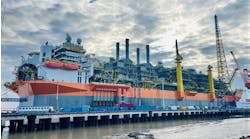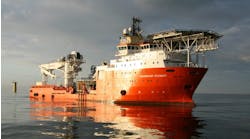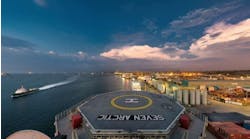Subsea construction is under way on theG17 field in the Dutch North Sea, with contractor Noordhoek applying a brand new diving system. The Transfer Under Pressure (TUP) system recently gained approval and certification from Lloyds Register following trials on the multi-purpose diving support vesselNoordhoek Singapore. Simultaneously, the vessel underwent its annual DP2 dynamic positioning test program before returning to base in Den Helder.
Noordhoek, based in Zierikzee, designed and built the system in house in association with its subsidiary Seatec Underwater Systems. Unlike traditional shallow water diving spreads, which typically incorporate a wet bell or submersible basket, the TUP features a closed bell similar to those deployed for saturation diving. The main advantage of this approach, the company says, is that there is no surface decompression interval. This lessens the risk to the divers of decompression sickness. Other advantages are increased windows for activity at the working depth, and also the possibility of back-to-back diving programs.
The TUP comprises the following main components:
• A large three-man diving bell
• Clump weight/stand-off frame
• Dedicated bell handling system
• Transfer chamber
• Triple lock decompression chamber
• Dive control station.
The TUP allows three divers to be launched with the door closed until they reach the working depth. Only then is the bell pressurized in line with this depth, thereby increasing the bottom time working period. Also, when the bell has reached working depth, two divers lock out and proceed to the work site while the third diver, or ‘bell man,’ remains inside the bell as a standby diver. On their return to the bell, the door is closed and pressure inside the bell lowered to the first decompression stop, while returning to the surface.
On reaching the surface, the bell is locked onto the transfer chamber. Bell and chamber pressure are then equalized, with the divers entering the triple lock chamber and starting decompression. This leaves the bell and the first compartment of the triple lock chamber free for the next group of divers. The crew breathes a Trimix gas mixture consisting of helium, nitrogen and oxygen. This mixture allows longer periods of bottom time.
On completion of trials offshore, the Noordhoek Singapore started work on G17 for Gaz de France Production Nederland. Phase one of this program involved installing a 24-in. spool between the K2-NGT trunkline side-tap and the 24-in. export pipeline to Wintershall’s planned new platform in block F16. The vessel also installed a 12-in. spool from the side-tap to the future K2-B pipeline. Prior to starting Phase 2 of the G17 subsea construction at the end of last month, the TUP diving system was also involved in remedial work for GdF and Wintershall, again in the Dutch sector.•




